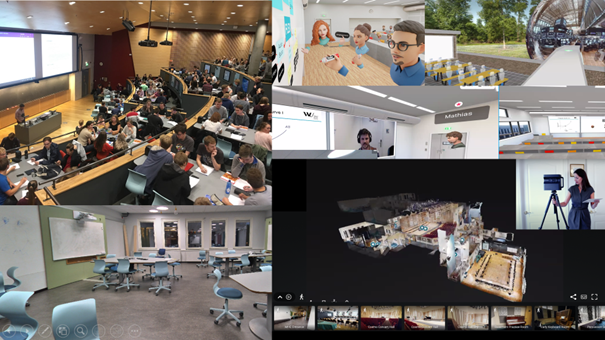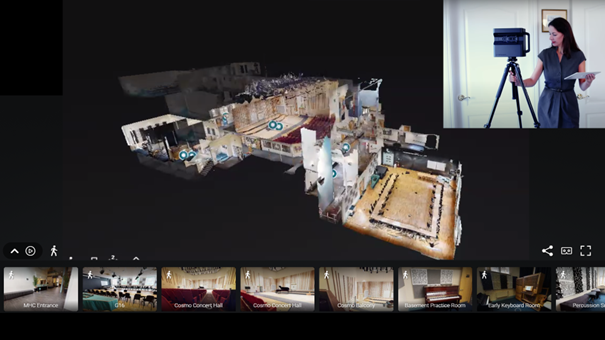by Zac Woolfitt, Inholland University, The Netherlands.
Technology developments create new opportunities for teaching and learning in technology-rich learning spaces.
Post pandemic, we returned to learning and teaching in physical classrooms, interacting with teachers and fellow students in person and reflecting on what makes in-person learning so valuable. But we took something from the pandemic with us. We continued teaching online, through hybrid virtual learnings spaces, live streaming lessons to different physical and virtual environments. The next step is when we start navigating through digital twins of real classrooms before visiting them in person. At which point we can become avatars, interacting with other learners as we discuss ideas and asking questions in 3d virtual spaces. The edges between physical and virtual learning spaces are fading as we develop competence in teaching and learning in these evolving contexts.

On 23 February the Media and Learning association ran a ‘virtual tour’ of advanced learning spaces. (Disclaimer: as a member of the Media and Learning Advisory Committee I moderated this session).
On the virtual tour we visited the University of Manchester, The Norwegian University of Science and Technology, and the Vienna University of Economics and Business. More than thirty technical and pedagogical professionals from institutions around Europe joined the session.
(See the full webinar recording here, timings of presentations listed below)
This article covers:
- Matterport ‘Digital Twin’ of Music and Drama Center (Manchester University) (03:00)
- Redesigned lecture theatre for interactive group discussions (Norwegian University of Science and Technology. (23:00)
- Avatar interactions in a fully virtual learning space (Vienna University of Economics and Business) (43:00)
- Discussion and next steps
Manchester University Virtual Twin of campus
During the pandemic it was not possible for students to visit physical locations on campus. Post pandemic, students may have lost some of their ability to navigate through complex campus spaces. It can be anxiety inducing trying to find your way around large spaces. To compensate for this, the University of Manchester built a 3D virtual ‘twin’ of their Music and Drama centre. Users navigate through the virtual environment freely, moving between each scanned space. Information ‘tags’ have been added to the virtual world to explain appropriate use of spaces and instruments, and videos were added to show performances from current staff and students. This has reduced the time that staff needed to explain the facility to students. It has also made it easier for students who are using the center to get a sense of the space they are studying in advance, to find specific locations more easily, and to follow the rules regarding equipment use.

Rebecca Oldfield, Kar Stanton, and Alexandra McGaughrin Cross took us through the virtual space and explained how they had made it. Creating the twin involves taking multiple 360 photographs of the location. The route needs to be carefully planned in advance, doors need to be left open for continuity and to create a sense of openness. The auditorium proved quite complex due to the split level and repeating patterns of chairs, so this took some careful positioning and several attempts to avoid confusing the software. They estimated they did about 300 scans in total to create the twin. During each scan, the photographer needs to ‘duck down’ as the camera swivels around, to avoid being in the picture.
Once the locations were scanned, several multimedia layers were added. These includes quizzes, video links, and information about how to access, use, and pack-up the equipment after the session. Before using the rooms, students can answer a quiz to test their knowledge on the basic protocols. This project has resulted in students being informed in advance about how to use the equipment and rooms, and it no longer requires support staff to give as many explanations, but to provide support at different levels.
However, once you’ve created your twin, it is not so easy to update and adjust the rooms (if they change). This is a downside since at a certain point, the digital rooms will not match reality. An article on Media and Learning gives further information about this project, and Manchester Universities good practices site explains their use of Matterport.
Norway NTNU – Interactive Lecture Hall
Magnus Sæternes Lian of the Norwegian University of Science and Technology (NTSU) showed us two of the technology rich learning spaces they have developed. Although they were set-up before the pandemic, they were a nice contrast to the other virtual spaces visited during the webinar. And since they’ve been around for a while, they have built up experience on how to use the learning spaces creatively.
The first room (Lecture hall combined with group work) caught my attention sine it combined two pedagogical concepts. Firstly, as lecture hall, it can be used for one-directional ‘sending’ of content. Secondly, rather than a row of chairs sloping up, it had been reconfigured to include multiple project group tables where students could interact during the lecture. Combining these two elements is certainly ambitious, and it allows for a more interactive lecture. However, placing these desks here does reduce the overall capacity of a large lecture room so it is unlikely this layout will be used in many other locations.

The second room Magnus showed was set-up for interactive sessions combining classroom and online interactions. You can tour the space here. This classroom is equipped with project desks which can beam their work onto a local screen, and many local microphones [1] in the ceiling of the room which pick up student interactions. For the in-classroom interactions they use WePresent from currently Barco, and also Mersice Solstice and are considering trying out Airtame.

NTNU has several other interesting rooms set up on their campuses so take a look at their photo galleries for inspiration: ZoomRoom WebinarBooths and a Panopto/ZoomRoom TV studio with 4K Multicamera for webinars and lectures.
Vienna – Virtual Worlds
In the final presentation, we moved to the next dimension. Florian Mosböck and Mathias Janko of WU Vienna (University of Economics and Business) took us through the virtual world they have developed. They have been focusing on building a virtual campus in order to support international classrooms more. On the tour they guided us through their “Future Learning Experience Center”, and explained what it took to set it up, and different ways it is used.
In the virtual classroom, students and teachers interact with each other as avatars in real time. You can have some input into what you avatar looks like when you set up your profile to enter the space. They have developed two virtual locations. The first one is a traditional lecture hall, with banked seats. The second space is an outside courtyard with benches with a doorway to a 360 scan of inside the New York stock exchange. This combines a fully imaginary space, but connects to a scan of a real world space.

The learning space they have created can supposedly hold up to 80 avatar students at one time. The most they have had interacting is around 40 which must challenge the bandwidth. How to teach and learn effectively in this space is a question that is of interest not only to us, but to those investing in developing learning spaces in the Metaverse [2].
In their presentation, they showed us how you can ‘spawn’ a 3d object, in this case an apple. As your avatar in the space, you can move around the room and look at the object from different positions. The virtual lecture hall has two white boards where the lecturer can project their slides, add quizzes, graphs, other images. They can project their own video feed with their face onto this space to be visible not as an avatar but as a talking head. The idea is that students can collaborate on mind maps, pick-up pens to write, and add ‘sticky notes’ to the virtual space. We wondered if a sloped row of benches was actually necessary for a virtual world, as the current spaces copy our familiar classroom arrangements. It will be interesting to see how these spaces develop.
As a learner, you can move around the room. When you move closer to another (avatar) student, you can hear them and talk to each other. As you move away, their voice becomes quieter until you can’t hear them any more. In the outside setting, there are tables and benches. Student (avatars) move to a bench and sit down with other students. At that point, you only hear the other students at your table talking, like a project group. This technique has been used in other virtual meeting tools such as Mibo and Wonder. The system they use is ‘Hubs’, an open source, web-based tool for collaboration and communication. It works on a variety of devices such as a VR headset, a PC or a smartphone. Hubs offer similar interaction possibilities as MS Teams or Zoom. The focus is on the immersion of being together.
This virtual space cannot recreate actual classroom interactions. However, it has been designed to bring together disparate groups of international students. They would not normally be able to meet in person, and this format is very different than an online class with the fixed grid of Zoom faces staring at you. Being an avatar may reduce some social anxiety and make entry into conversation and interaction easier.
In a previous article on Media and Learning, Oliver Vettori of Vienna WU gave some more information on their approach and noted ‘there is an element of the physical attached to every virtual space.’ He commented that there is a ‘clear need, but also to a considerable opportunity to rethink the notion of “space” in higher education at the present time’.
I would be very interested to have a chance to teach in this space to see how the interactions work, and what sort of learning goals are most suitable for this context. I even suggested that we host one of our future Media and Learning webinars in this context as an experiment. We shall see!
Discussion and where next?
After the three presentations, there was time to discuss technical and pedagogical issues, as well as the practicalities of cost and scalability. It was an inspiring session. The webinar moved from a fully digital twin of an actual physical campus location in Manchester, to the physical spaces of interactive lecture halls and classrooms in Norway, and ended in the virtual world as avatars in Vienna.
Finding the right way to design and equip rooms for flexible teaching in different modes is an ongoing process of experimentation. We are only starting the journey of teaching and learning in virtual spaces.
Thank you
Many thanks to all of the presenters for making time to share their expertise with us. Thanks also to Sally, Chloé and Dovi from Media and Learning for arranging the seminar. Thank you to you for reading this far. If you’ve got questions, or suggestions for additions or adjustments to the text, please email me at zac.woolfitt@inholland.nl.

Author
Zac Woolfitt, Lecturer and Researcher, Inholland University, The Netherlands
References:
[1] (Ceiling Microphones: They use Biamp Parlé TCM-X Ceiling microphones and are using AWB to connect them to the DSP Biamp Tessira server.)
[2] What is the metaverse?: https://about.meta.com/what-is-the-metaverse/













